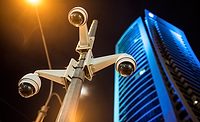Techniques and algorithms for video surveillance analytics

Image from Unsplash
Video surveillance technologies are becoming ubiquitous in modern-day society. Visit any building in the public domain globally that permits the general public to attend, stop at a vehicle traffic light, or consider the number of household video surveillance cameras homeowners are installing at very fast rates, and one can quickly ascertain the speed at which the technology is being implemented.
The process of manually monitoring or reviewing video surveillance can be arduous and inefficient. Additionally, using automation and analysis techniques to search surveillance output requires the use of algorithms and intelligence.
With the increases in video surveillance technology implementations, a natural evolution is to add or complement the technology with ways to deploy the use of analytics techniques to better use existing solutions. By using algorithms or technical techniques, there is the potential for end-users of video surveillance solutions to more quickly respond to situations requiring video evidence prior to or post-incident. With the application of additional algorithms, there is the potential for greater object detection or sensing using mathematical calculations.
Growing implementation and use of video surveillance technologies can be aligned with the rapid movement toward Internet of Things (IoT) devices. Video surveillance technologies are considered the most increasing element of this evolution and the industry’s annual growth rate is expected to hit $144.8 billion by 2027, increasing by 14.6% within the timeframe of 2020 to 2027. Being able to analyze data efficiently is critical, and the use of algorithms and techniques in data analysis is pivotal to quicker security response.
The use of algorithms in video surveillance
A variety of algorithms may be employed when analyzing captured or live video surveillance digital traffic. Particular algorithms can be created for particular industries, such as transportation, police use, and firefighting, as well as for specific needs, such as facial recognition, detection of a particular movement or motion, or detection of an object.
The technical integration of algorithms can be deployed centrally, at the backend of a server farm, the cloud, or the endpoint device, such as a video surveillance camera. With proper algorithm design, a wide range of image detection and processing can be performed and is often seen in the physical security field.
Available open-source libraries & modules
Due to the widening availability of hardware and the use of IoT devices in security, many open-source libraries, modules and platforms have formed to allow a wider base of capabilities not necessarily inherent to the hardware itself or as a standalone product base. Open-source packages can vary in size and scope; however, many of these platforms can be used to run in other open-source solutions for containerization and micro-services-based architectures. This can allow enterprise-level scaling from hundreds to thousands of devices, adding levels of automation and centralized management.
In many cases, these libraries and separate modules can provide support to a wide array of devices, such as commercially available camera systems that utilize standard communication methodologies, IoT-based specialized camera systems, and isolated USB cameras.
The use of open-source libraries also allows for wider support via community-based updates. Focusing on the advantages, open-source libraries and modules allow active developers to assist with updates, bug fixes and support with some open-source platforms allowing additional options for dedicated support through paid services and licensing.
Vendor add-on options for video surveillance
Enterprise-level video surveillance solutions can include a large number of infrastructure servers, communication and network technologies, vast numbers of endpoints, and the potential for third-party integration solutions. Video analytics can be integrated with video management systems (VMS) to help augment the installed solutions with artificial intelligence (AI).
In addition, vendors can provide large-scale storage options to help meet ongoing retention requirements that may provide an organization the ability to scale for large datasets. A multi-node surveillance system that spans multiple geographies may require terabytes of storage accessible from anywhere. Software as a Service (SaaS) and further implementation of APIs allow organizations better oversight, management, and overall scalability options to access and manage video data.
Machine learning, artificial intelligence and algorithms
When it comes to types of algorithms positively affecting video surveillance capabilities, machine learning (ML) has simplified and automated computer vision and digital image processing. The improvement of data streaming, cloud services offering, and processing technologies allow machine learning algorithms to detect the objects or persons within a live streaming video.
Based on the type of machine learning, many algorithms and libraries could be deployed to process digital images, feature point detection, human-computer interaction (HCI), facial recognition, signature pattern detection in banking, digital documents analysis, and smart tag-based vehicles for recognition.
Other algorithms that are utilized to differentiate moving items can perform well in various conditions, such as low illumination. For example, the Gaussian Mixture Model (GMM) algorithm employs its process on individual pixels. The YOLO algorithm model attempts to simulate the function of a human retina, using the probability of positive tracking of objects, by utilizing the input of the charged-coupled device (CCD).
Emerging tools and technologies
The addition of artificial intelligence has offered increasing capabilities in enterprise-grade video surveillance systems, spawning new platforms and evolving existing technology providers that allow real-time capabilities to perform a tremendous amount of analytics in a fraction of the time of manually attempting to analyze data.
These systems can allow operators to map various known people and objects. The use of AI provides enterprise-level systems to go beyond simple recognition. These systems can allow behavior-based analytics that can also track not only the object but also patterns in the object’s movement and abnormalities.
With the accumulation of video footage, AI can be leveraged to better analyze data looking for triggers, anomalies and other data points to better inform or predict the user and organization where events may occur. AI can efficiently analyze data within video streams, significantly reducing the human factor in dealing with the manual task of combing video records. And, by building in more automation, more platforms are driving toward building efficiencies around giving users a single pane of glass to manage and easier ways of disseminating information. The task of viewing tens, hundreds, or even a thousand video feeds would be an impossible task for a single user and would not scale for organizations to staff accordingly.
Concerns with and goals for video analytics
A concern related to algorithmic threat detection is reducing the number of false positives. Another such area of concern is related to individual privacy and a reasonable expectation of privacy as a right. By integrating and using developed algorithms, there is the expectation that the intelligence will only improve, which is good for societal security and awareness.
The growing implementation of video surveillance technology has continued to gain steam in many different environments and uses globally — as the expectation of surveillance is the potential to aid those individuals and professionals that would benefit from enhanced safety, security, and awareness. The integration of algorithms adds value to video surveillance technology by permitting greater automation and the ability for specific quality detections.
Looking for a reprint of this article?
From high-res PDFs to custom plaques, order your copy today!









